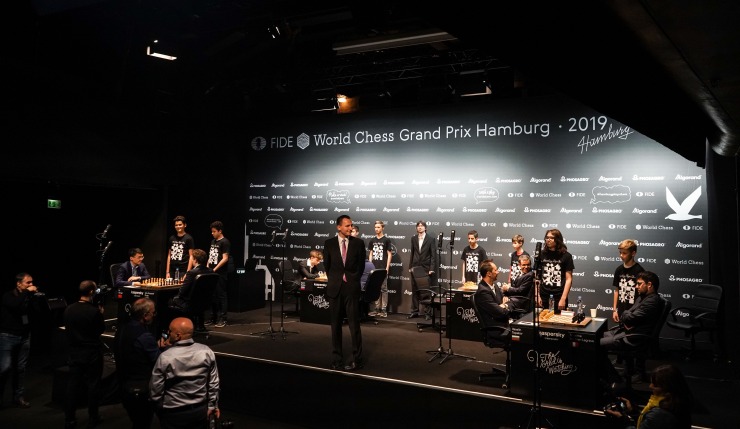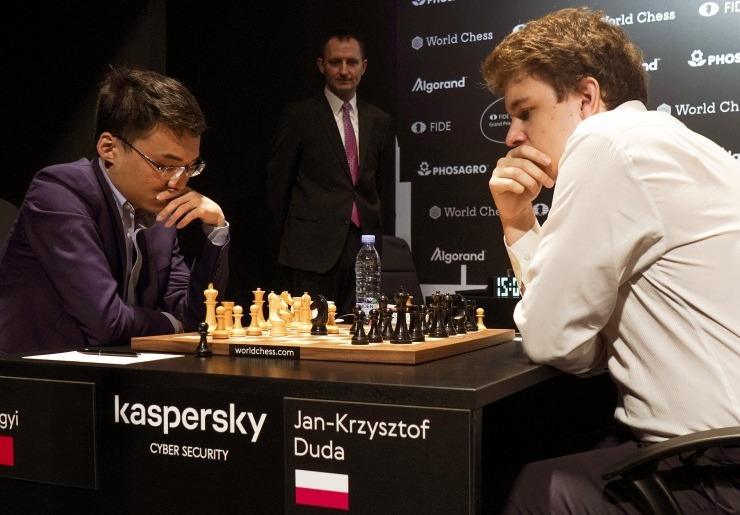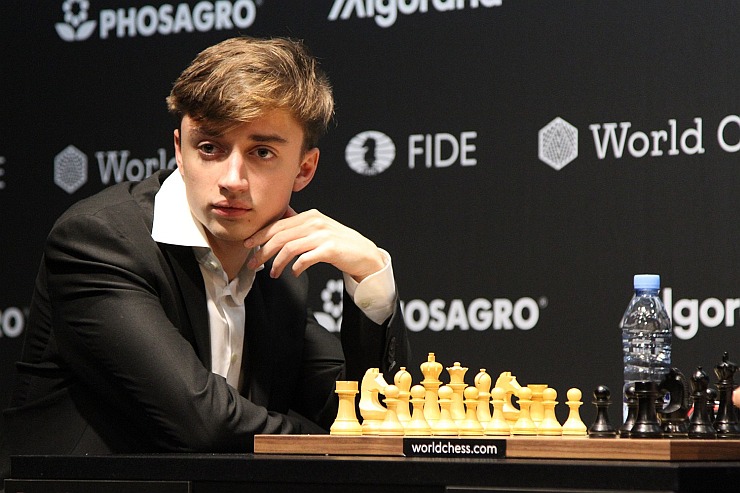Hamburg is known as a hub of chess activity. The city in northern Germany hosts one of the largest clubs in Europe that has its clubhouse and a long tradition dating back to 1830. Additionally, the Chess in Schools project has been successfully supported by the local associations and authorities for decades. One result of these steady efforts is the annual “Alsterufer” match with more than 100 schools and nearly 4000 kids participating.
One of the winning teams of this annual match, consisting of eight children, was invited onto the stage to open the first game of the second round of the FIDE Grand Prix.

Vachier-Lagrave does it again
Maxime Vachier-Lagrave is the only winner of the day. The French grandmaster chose his beloved Grünfeld Defence with Black against Veselin Topalov who opted for a sideline which transposes the position into a Benoni-like-structure. In a highly complex middlegame, the Bulgarian grandmaster used one of his trademark exchange sacrifices to complicate matters even more.
In time trouble, both players attacked the enemy’s king and risked everything. Topalov committed the final mistake on move 36. He could have sacrificed a piece and hide his king in the corner, but this was extremely difficult to spot. Instead, he allowed his opponent to win very important b-pawn. In the end, Vachier-Lagrave found a lovely combination to force a queen exchange and promote his passed pawn.
Yu Yangyi misses a possible win
Yu Yangyi demonstrated a fantastic preparation once again. In the main line of the Petrov’s Defence, which the Chinese grandmaster often uses himself, he presented an interesting novelty on move twelve, which immediately put pressure on his opponent. Duda spent about an hour for the next six moves but landed in an inferior position. Yu Yangyi played a perfect game until 27th move. In a heavy piece endgame, he had a strong passed pawn on e6 and could dominate the situation with a quiet queen move. Instead, he lost two tempi with unnecessary rook moves. Duda was able to activate his queen and force a draw by a perpetual. “When I played my rook to e5 I completely missed that he can activate his queen”, Yu Yangyi confessed after the game.

Alexander Grischuk and David Navara followed the main line in the Catalan Opening that the Russian grandmaster used to beat Leinier Dominguez Perez in the third round of the World Cup in Khanty Mansiysk. After exchanging three minor pieces, Grischuk pinned his hopes on slight space advantage and a better minor piece, but Navara’s position remained solid. Alexander spent a lot of time, but he couldn’t find a way to put Black under serious pressure. Navara countered with a well-timed centre push, and the position soon petered out into an equal queen endgame.
In a battle of generations, the Russians Daniil Dubov and Peter Svidler discussed an important theoretical line of the Grünfeld Defence. White started to build up a strong centre but Svidler timely undermined it with typical counters even at the cost of a pawn. Afterwards, both players agreed that objectively White should hold an advantage. Over the board, Dubov wasn´t able to demonstrate this statement to be the case. With his time running down, Dubov decided to avoid unnecessary risks and offered a draw on move 23.

Round 2, game 1 results:
Veselin Topalov – Maxime Vachier-Lagrave 0-1
Alexander Grischuk – David Navara 1/2-1/2
Daniil Dubov – Peter Svidler 1/2-1/2
Yu Yangyi – Jan-Krzysztof Duda 1/2-1/2
Official website and LIVE broadcast: https://worldchess.com
FIDE Press officer for the event: Georgios Souleidis
Official Photographer: Valeria Gordienko
World Chess contact: media@worldchess.com
Photos are available for the press from the following link to Dropbox.
Leading partners supporting the FIDE World Chess Grand Prix Series 2019 include:
Algorand as the Exclusive Blockchain Partner
PhosAgro as the Official Strategic Partner
Kaspersky as the Official Cybersecurity Partner
Pella Sietas Shipyard as Official Partner
Prytek as the Technology Transfer Partner







